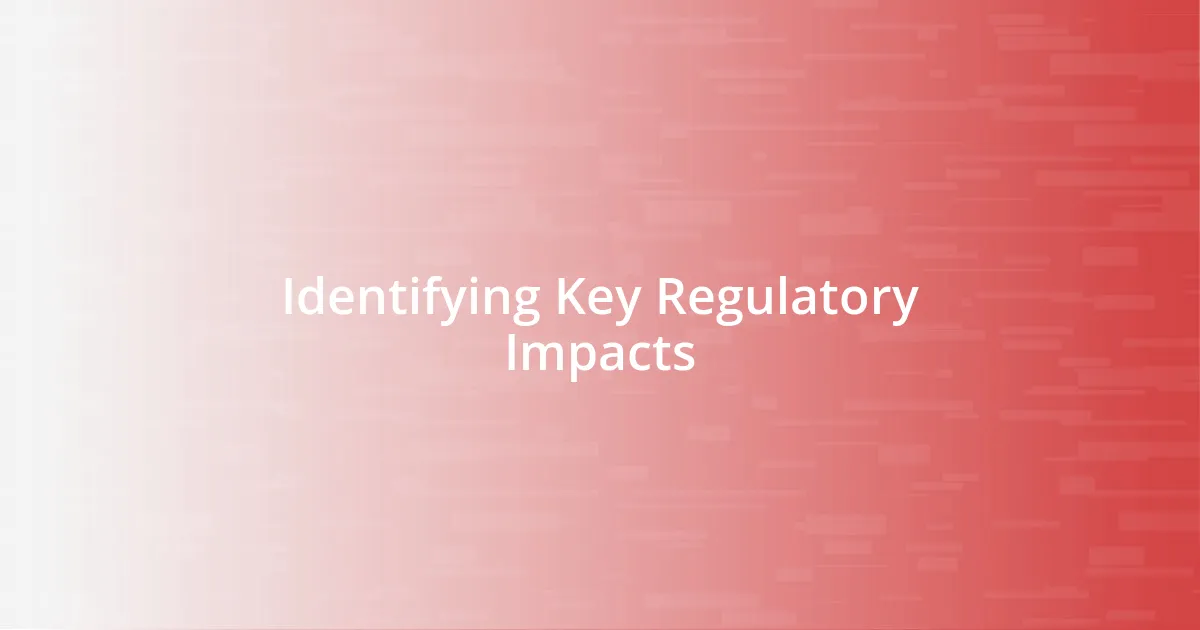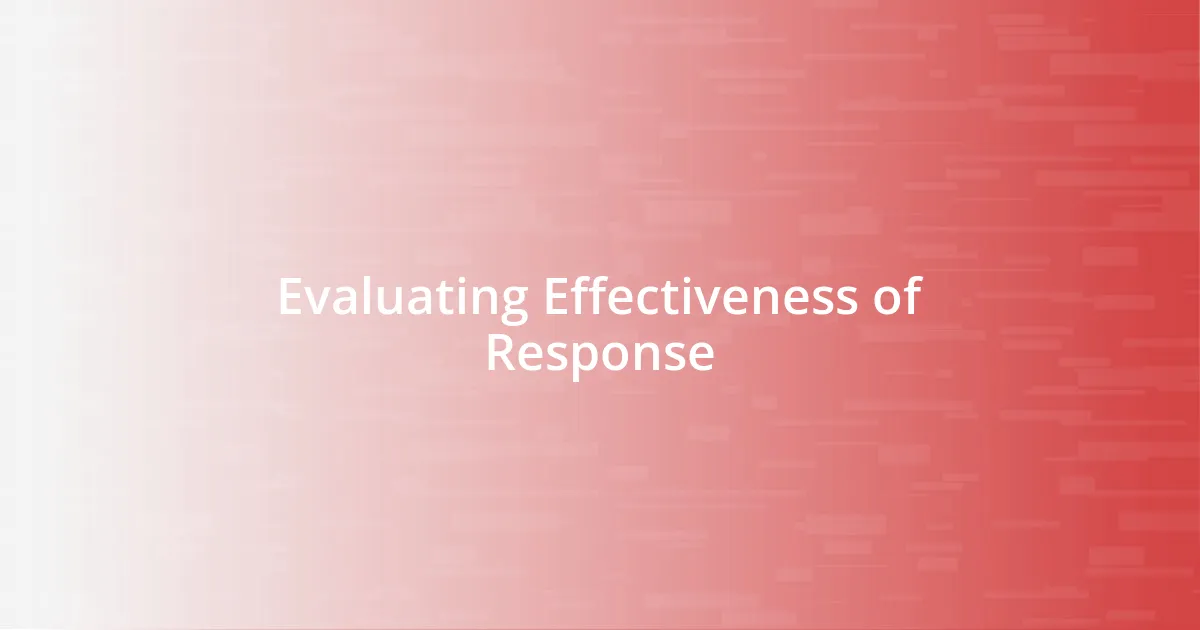Key takeaways:
- Understanding the rationale behind regulatory changes helps in embracing them and turning challenges into opportunities for business growth.
- Proactive engagement with regulations and building relationships with regulatory offices lead to smoother adaptation and innovation within compliance processes.
- Implementing a structured action plan and fostering open communication among teams enhances compliance while also promoting a sense of ownership and collaboration.
- Regular evaluation of compliance effectiveness and anticipating future regulations empowers organizations to adapt strategically and maintain resilience.

Understanding Regulatory Changes
Understanding regulatory changes can feel like navigating a labyrinth, where each twist and turn brings new challenges. I remember the time a significant policy shift impacted my industry overnight. The initial shock was daunting; I questioned how my business would adapt.
As I delved deeper into the changes, I realized that these regulations were designed to protect consumers and promote fairness. It struck me how crucial it is to comprehend not just the letter of the law but the spirit behind it. Why is it that some people resist compliance? I found that understanding the ‘why’ often helps in embracing necessary changes.
Reflecting on my journey, I’ve seen firsthand how a proactive approach can turn potential chaos into opportunity. By engaging with the new regulations early, I could adjust my strategies and even enhance my business practices. Isn’t it fascinating how what initially seems like a hurdle can, with the right perspective, lead to growth?

Identifying Key Regulatory Impacts
When it comes to identifying key regulatory impacts, I often start by closely examining how these changes align with our company’s values and long-term objectives. I recall when new environmental regulations prompted us to rethink our production processes. It wasn’t just about compliance; it was an opportunity to showcase our commitment to sustainability, which resonated well with our customers.
I find that categorizing the implications of regulatory changes can simplify the assessment process. For instance, I regularly create lists that differentiate between immediate operational impacts, such as changes in compliance costs, and potential long-term shifts, like market perceptions. This allows my team and me to prioritize our responses effectively and allocate resources where they are most needed. Have you ever noticed how the initial reaction to regulatory shifts can spark innovative ideas? In one instance, a compliance requirement led us to revamp our reporting system into something more user-friendly and efficient.
Analyzing past experiences is invaluable. In my case, early engagement with regulatory offices made it easier to navigate subsequent changes. It helped me recognize trends before they became obligations. By building relationships and staying informed, I realized the importance of being proactive rather than reactive. This approach not only alleviated stress but also positioned our company as a leader in adapting to regulations.
| Regulatory Change | Key Impact |
|---|---|
| Environmental Regulations | Enhanced sustainability practices |
| Data Privacy Laws | Increased compliance costs |

Developing an Action Plan
Creating an action plan in response to regulatory changes is essential for success. I remember the nerve-wracking moments when I faced new compliance requirements; diving into strategizing felt overwhelming initially. However, breaking everything down into manageable steps made the task less daunting and more achievable.
Here’s how I typically approach developing my action plan:
- Assess Impact: Determine how the regulatory changes affect specific areas of my business.
- Set Clear Objectives: Define what success looks like in compliance.
- Allocate Resources: Identify the team members and tools needed to implement the changes.
- Establish a Timeline: Outline when each step should be completed to stay on track.
- Communicate: Keep all stakeholders informed to ensure everyone is aligned and prepared.
As I crafted my action plan, I often felt a mix of excitement and anxiety. It’s all about taking ownership of the situation and making it work for my benefit. For instance, I once coordinated a team brainstorming session to discuss regulatory impacts. This collaboration not only generated fresh ideas but also fostered a sense of camaraderie. It’s incredible how rallying together can transform a regulatory challenge into a motivating experience.
Remember, a proactive approach allows room for flexibility. Regulatory environments can shift unexpectedly, and being adaptable is key to staying ahead. I have learned that reviewing my plan regularly helps to refine it and ensures that we remain reactive to new developments.

Implementing Compliance Strategies
When it comes to implementing compliance strategies, I believe in laying a strong foundation. I often start by creating a compliance framework that aligns with our organizational goals. This means not just checking boxes but integrating compliance into our everyday operations. I remember a time when we updated our training programs; instead of seeing compliance as a burden, we turned it into an engaging initiative. Employees shared how they appreciated the refresh—it made them feel involved in the process, rather than simply being subjected to regulations.
One aspect I find crucial is fostering an open dialogue among my team. I tend to hold regular check-ins where everyone can voice concerns or share insights about compliance challenges they encounter. This approach not only helps catch potential issues early but also encourages innovative thinking. Have you ever considered how a simple conversation can lead to unexpected solutions? I was surprised when a team member suggested a digital compliance dashboard, which not only streamlined our reporting but also made transparency a breeze.
It’s important to recognize that compliance is not a one-size-fits-all solution. Customizing my strategies based on our unique business context has proven essential. For instance, I once collaborated with our IT department to tailor data privacy measures that were well-integrated into our existing systems. This collaboration fostered a sense of ownership across departments, making compliance a shared responsibility rather than a solitary task. By actively involving diverse teams, we not only adhered to regulations but also strengthened our company’s overall resilience.

Monitoring Ongoing Changes
Monitoring ongoing changes in regulations is a vital part of my compliance strategy. I can’t stress enough how keeping a pulse on the evolving landscape is essential. When I first started tracking regulatory shifts, I felt overwhelmed by the volume of information available. To manage this, I created a simple system utilizing alerts and newsletters specific to my industry, which streamlined the process and vastly improved my awareness of relevant changes.
It’s fascinating how these ongoing changes can ripple through my business operations. The last time I adjusted my compliance processes was after realizing new labor laws had been enacted. I immediately gathered my HR team to discuss potential impacts. That conversation was eye-opening; we uncovered several areas that needed immediate attention. Have you ever experienced that moment of clarity when a simple discussion leads to crucial adjustments? I certainly have, and it’s moments like these that reinforce the importance of proactive monitoring.
As part of my routine, I typically allocate time each week to review updates, ensuring they align with our strategic goals. I remember when there was a significant change in data privacy regulations; I felt a mix of apprehension and determination. But dedicating just a couple of hours each week transformed my perspective from reactive to proactive. It became second nature to not only track changes but also analyze how we could leverage them to enhance our practices. Isn’t it rewarding when you can turn potential obstacles into opportunities for growth?

Evaluating Effectiveness of Response
Evaluating the effectiveness of my responses to regulatory changes is where the real learning happens. I’ve often found that setting measurable objectives is crucial. For instance, after implementing a new compliance strategy, I tracked training completion rates and assessed employee feedback to see how well the initiative resonated. Seeing a marked increase in both areas gave me confidence that we were on the right track. Isn’t amazing how data can transform perceptions?
However, evaluation goes beyond mere numbers. I recall a time when we rolled out a new compliance protocol, and initially, I was thrilled by the positive feedback. Yet during a follow-up meeting, some team members voiced challenges that hadn’t been on my radar. Their insights were invaluable and reminded me that context is everything. Have you ever had an experience where a seemingly successful initiative revealed hidden difficulties? I sure have, and it highlighted the importance of ongoing, two-way conversations.
Lastly, I believe in revisiting and refining my strategies regularly. About six months after a significant regulatory shift, I initiated a roundtable discussion to gather fresh perspectives and adjust our approach. It was eye-opening; the keen insights from various departments ignited a new wave of innovation in our compliance efforts. Armed with this feedback, I crafted a more tailored strategy that integrated their ideas, showcasing how collaboration enhances effectiveness. How do you measure the impact of your responses? That’s something I continually strive to answer.

Adapting for Future Regulations
Adapting for future regulations involves anticipating changes rather than just reacting. One afternoon, I found myself pouring over potential legislative trends that could shape our industry in the next few years. As I drafted a list of possible upcoming regulations, I realized that proactive adaptation could safeguard our business against compliance shocks. Isn’t it fascinating how a mere forecast can influence strategic planning?
I began integrating scenario planning into our compliance framework, which made a world of difference. For instance, when discussions around sustainability regulations grew louder, I organized brainstorming sessions with my team to explore how we could not only comply but lead in sustainability initiatives. Their creativity sparked ideas that went beyond mere compliance; we set ambitious goals that elevated our brand image and employee engagement. Have you ever had a moment where thinking outside the box transformed your approach to a potential regulatory challenge?
As I reflect on these experiences, I can’t help but feel a sense of empowerment through adaptability. Recently, after attending a workshop on regulatory trends, I returned to the office bubbling with new ideas. I engaged my team in conversations about compliance empowerment, fostering a culture where everyone felt encouraged to contribute to our strategic direction. This shift in mindset not only made us more resilient to change but also created a unified purpose within the team. Don’t you agree that when everyone is involved, the path to adaptation is much smoother?















